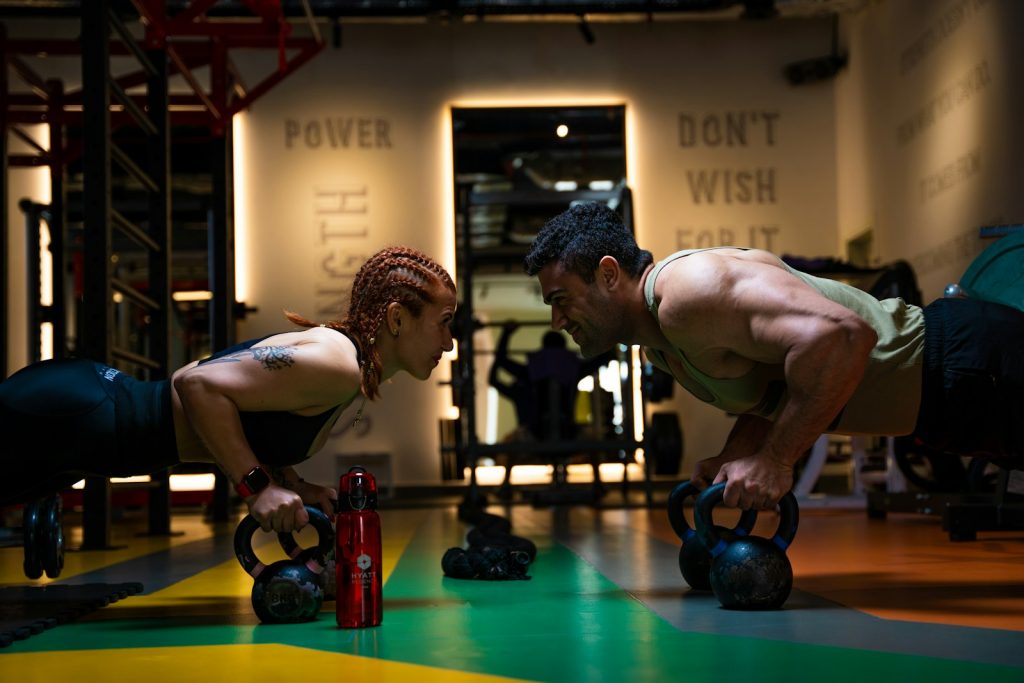10 Shocking Fitness Myths: When it comes to fitness, there’s no shortage of myths and misconceptions that continue to mislead even the most well-intentioned exercisers. Some of these myths may sound logical, while others are downright outdated. Whether you’re trying to lose weight, build muscle, or simply stay healthy, it’s essential to separate fact from fiction to avoid wasting time and effort. As the editor of StarAvis.com and a fitness enthusiast, I’ve encountered many of these myths firsthand and have done the research to debunk them. Here are 10 shocking fitness myths you probably still believe—and why you should stop.
1. Myth: Crunches and Sit-Ups Will Give You a Six-Pack
The Truth: Abs are made in the kitchen, not just in the gym.
One of the most persistent myths is that doing hundreds of crunches and sit-ups will give you visible abs. While these exercises can strengthen your core, they won’t necessarily burn the fat covering your abdominal muscles. Spot reduction—losing fat in specific areas by working those muscles—simply doesn’t work.

The Reality:
- Diet is Key: Visible abs come from reducing overall body fat, which is achieved through a combination of a healthy diet and full-body workouts.
- Full-Body Workouts: Incorporate strength training and cardio exercises that target all muscle groups to burn more calories.
Better Approach: Focus on reducing overall body fat through calorie control and full-body exercises like squats, deadlifts, and high-intensity interval training (HIIT) to reveal your abs.
2. Myth: Lifting Weights Will Make Women Bulky
The Truth: Women naturally have lower levels of testosterone, so bulking up isn’t that easy.
Many women avoid lifting weights out of fear that they’ll develop a bulky, masculine physique. In reality, strength training helps women build lean muscle, burn fat, and tone up, without the bulk. Female bodybuilders often follow extremely strict diets and intense training regimens, along with supplements, to achieve their muscular look.

The Reality:
- Toning Up: Strength training can give you a leaner, more toned appearance by building muscle and reducing body fat.
- Fat-Burning: Muscle burns more calories at rest than fat, so lifting weights can actually help you lose weight and get leaner.
Better Approach: Incorporate strength training into your fitness routine to build a strong, toned physique without fear of bulking up.
3. Myth: More Sweat Means a Better Workout
The Truth: Sweating is not always an indicator of workout intensity.
While sweating can be a sign that you’re working hard, it’s not a definitive measure of how effective your workout is. Sweating is your body’s way of cooling itself down, and factors like temperature, humidity, and hydration levels can affect how much you sweat.

The Reality:
- Exercise Efficiency: Focus on the quality of your workout—intensity, form, and progression—rather than how much you sweat.
- Body Type: Some people naturally sweat more than others, and sweating doesn’t necessarily correlate with fat loss or fitness gains.
Better Approach: Instead of using sweat as a benchmark, track your workout intensity by monitoring heart rate, perceived exertion, or performance metrics like weight lifted or distance covered.
4. Myth: Cardio Is the Only Way to Lose Weight
The Truth: Strength training is just as important for weight loss.
While cardio is great for burning calories during a workout, it’s not the only—or even the best—method for long-term fat loss. Strength training builds muscle, which boosts your metabolism and helps your body burn more calories throughout the day, even at rest.

The Reality:
- Muscle Burns Fat: The more muscle mass you have, the more calories your body burns, even when you’re not exercising.
- Cardio + Strength: A combination of both cardio and strength training is the most effective way to lose fat and keep it off.
Better Approach: Include both cardio and strength training in your fitness routine to maximize fat loss and improve overall fitness.
5. Myth: You Need to Work Out for Hours to See Results
The Truth: Short, intense workouts can be just as effective.
Many people believe that long, drawn-out workouts are necessary for making progress, but research shows that short, high-intensity workouts can be just as effective—if not more so—than longer sessions. The key is maximizing effort in a shorter period of time.

The Reality:
- HIIT Workouts: High-Intensity Interval Training (HIIT) allows you to burn a lot of calories in a short amount of time and boost your metabolism post-workout.
- Quality Over Quantity: It’s better to have a focused, intense 30-minute workout than to spend 2 hours at the gym with minimal effort.
Better Approach: Incorporate 20-30 minute HIIT sessions or focused strength training into your routine to get great results without spending hours at the gym.
6. Myth: Running Is Bad for Your Knees
The Truth: Running itself doesn’t harm your knees—bad form and overuse do.
Many people avoid running due to the belief that it will lead to knee problems. While improper running form, worn-out shoes, or overtraining can cause knee issues, running itself is not inherently harmful. In fact, research suggests that running can actually strengthen your joints and improve bone health.

The Reality:
- Proper Form Matters: Running with correct form and wearing proper footwear can reduce the risk of injury.
- Rest and Recovery: Incorporating rest days and varying your workouts helps prevent overuse injuries.
Better Approach: Focus on running with proper form, invest in good running shoes, and include strength training to support your knees and joints.
7. Myth: You Have to Be Sore to Have a Good Workout
The Truth: Soreness is not always an indicator of an effective workout.
While muscle soreness, or DOMS (Delayed Onset Muscle Soreness), can happen after an intense workout, it’s not the only sign of progress. Just because you aren’t sore doesn’t mean you didn’t get a good workout. Consistency and progression are what really matter.

The Reality:
- Progress Over Pain: You can still make gains in strength and endurance without experiencing soreness after every workout.
- Listen to Your Body: Constant soreness could be a sign of overtraining or improper recovery, which could hinder progress.
Better Approach: Focus on consistent progression in your workouts, such as increasing weights or improving form, rather than relying on soreness as a sign of effectiveness.
8. Myth: You Can’t Build Muscle on a Plant-Based Diet
The Truth: You can build muscle on a plant-based diet with the right nutrients.
Some people believe that animal protein is the only way to build muscle, but many plant-based athletes and bodybuilders prove otherwise. You can build muscle and strength on a plant-based diet as long as you consume enough protein and essential nutrients like B12, iron, and omega-3 fatty acids.

The Reality:
- Plant Protein: Foods like lentils, quinoa, tofu, tempeh, and plant-based protein powders provide the protein needed for muscle growth.
- Supplement When Needed: Vegans and vegetarians should ensure they’re getting enough B12, iron, and other key nutrients, either through food or supplements.
Better Approach: Focus on consuming a variety of plant-based protein sources, and ensure your diet provides all the essential nutrients for muscle growth and overall health.
9. Myth: You Can Out-Exercise a Bad Diet
The Truth: Diet plays a crucial role in achieving fitness goals.
No matter how much time you spend in the gym, you can’t outrun a bad diet. What you eat plays a significant role in your energy levels, recovery, and ability to build muscle or lose fat. Consuming too many processed foods, sugary snacks, or excessive calories can negate your hard work in the gym.

The Reality:
- Calories Matter: Weight loss and muscle gain depend on consuming the right amount of calories and nutrients to support your fitness goals.
- Nutrient Quality: Focus on whole, nutrient-dense foods that fuel your body and provide the vitamins and minerals needed for optimal performance.
Better Approach: Pair your workouts with a balanced diet rich in whole foods, lean proteins, healthy fats, and complex carbohydrates to maximize your fitness results.
10. Myth: The More You Work Out, the Better the Results
The Truth: Rest and recovery are essential for progress.
Many people believe that working out every day without rest is the key to fast results. However, this can lead to overtraining, burnout, and injury. Your muscles need time to recover and rebuild after exercise, and rest days are crucial for making progress.

The Reality:
- Overtraining Risks: Pushing your body too hard without adequate rest can lead to fatigue, injuries, and stalled progress.
- Recovery Boosts Growth: Muscle growth and strength improvements occur during rest, not during the workout itself.
Better Approach: Incorporate rest days into your routine and prioritize sleep, hydration, and proper nutrition to aid recovery and maximize your fitness results.
Shocking Fitness Myths You Still Believe
These fitness myths have been around for years, but it’s time to leave them behind. By understanding the science behind effective fitness practices and making informed decisions, you can achieve better results and avoid the frustration that comes with misinformation. Whether it’s focusing on proper nutrition, incorporating strength training, or prioritizing rest, these changes will lead to a healthier, stronger, and more sustainable fitness journey.
At StarAvis.com, we’re committed to helping you achieve your fitness goals through evidence-based advice and practical tips. Remember, fitness is a lifelong journey, and the more you know, the better equipped you are to succeed.


